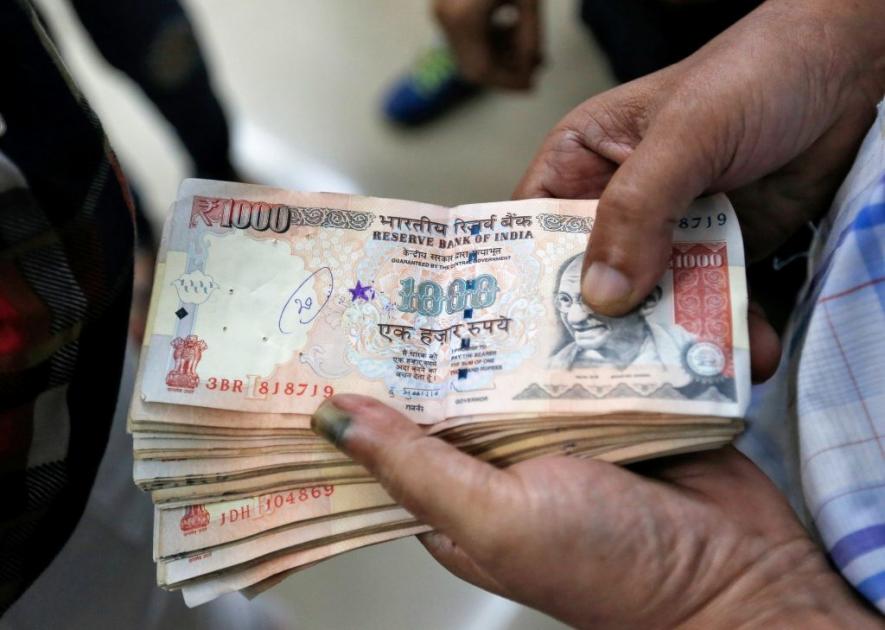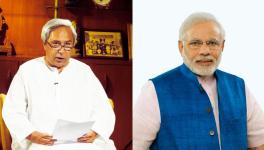Demonetisation: Most Reactionary and Illogical Policy Ever (Book Extract)

Image Courtesy: pbs.org
('Note-Bandi: Demonetisation and India's Elusive Chase for Black Money' is an upcoming book from Oxford University Press dedicated to the "memory of Indian citizens who lost their lives due to demonetisation"). Excerpts from the preface by R. Ramakumar.
'Demonetisation'-- the withdrawal of legal tender status of notes of denomination Rs 500 and Rs 1,000 -- announced by India's Prime Minister Narendra Modi over a televised address on 8 November 2016 will go down in history as one of the most reactionary and illogical economic policies ever attempted in independent India.
It crippled an economy that ran on cash and was plagued by a slowdown; it destroyed the livelihoods of millions of farmers, workers, traders, women and the elderly; and it violated the dignity and liberty of law-abiding citizens.
Yet, in a post-truth world, demonetisation also left public opinion in India deeply polarised. The language of the state had a deceptive appeal. In a society marked by abject poverty and inequality, and where everyday lives of citizens are marred by myriad forms of corruption, it came as no surprise that Modi's misadventure was received as a decisive measure.
Economists like me knew of the earlier demonetisation of 1978. But we also knew that it had failed to unearth any significant amount of black money. We were also aware of quack ideologues of the right-wing who demanded measures like demonetisation and the substitution of income tax with a blanket transactions tax. But we had also dismissed them as obscurantist drivel.
Never did one imagine that one among these irrational ideas would actually find a place in economic policy. Of course, many aspects of neoliberal economics are intrinsically inverted on logic. But the demonetisation of 2016 beat them all.
***
In his address to the nation, Modi made two major claims in defence of demonetisation: on the one hand, it would stamp out counterfeit currency that was aiding terrorism; on the other, it would help the government unearth ‘black money'. Soon after the address, one also heard television commentators waxing eloquent on India's imminent embrace of a cashless economy.
***
First, the claim that demonetisation would hit terror financing was overstretched because the total circulation of counterfeit currency did not exceed 0.002 per cent of the total notes in circulation. Second, no significant mobilisation of black money may be expected, as about 94 per cent of the unaccounted wealth was stored in the form of non-cash assets. Third, a cashless economy can never be created over diktats, as the persistence of cash was a structural feature of the economy.
What India needed was a structural transformation of its informal economy into a modern and productive sphere, which would systemically reduce the dependence on cash. A ‘war on cash' would thus be ineffective and premature. Sycophants apart, these views were also shared by economists across the Left-Right spectrum.
***
First, according to the Reserve Bank of India's (RBI) Annual Report for 2016-17, the total value of counterfeit notes of denomination Rs 500 and Rs 1,000 detected by banks rose from Rs 27.4 crore in 2015-16 to Rs 40.8 crore in 2016-17: an increase by just about Rs 14 crore. As a share of the value of Rs 500 and Rs 1,000 notes in circulation in November 2016, the value of counterfeit notes detected in 2016-17 amounted to just 0.0027 per cent. The critics were right; the extent of circulation of counterfeit notes did not, in any way, justify a drastic action like demonetisation.
Second, the RBI also released estimates of the value of old notes returned to the banks between 10 November 2016 and 30 June 2017. Out of the Rs 15.44 lakh crore worth notes of Rs 500 and Rs 1,000 in circulation as on 8 November 2016, about Rs 15.28 lakh crore had returned to the banks. In other words, 98.96 per cent of the demonetised notes were back in the banks and only 1.04 per cent remained outside. The return of about 99 per cent of the demonetised notes is the most important indicator of the failure of demonetisation.
In December 2016, the Attorney-General of India, Mukul Rohatgi, had informed the Supreme Court that the government did not expect more than Rs 12 lakh crore to be back in the banks. The remaining Rs 3 lakh crore was black money, which would not return to the banks and could be ‘extinguished' and passed on by the RBI to the government as dividend.
Red-faced, the government tried to contain the damage by claiming that demonetisation was intended to bring back all cash into the formal banking system. But in the public eye, the jury was no more out. There was no black money left to be ‘extinguished'.
Third, the Central Statistics Office (CSO) releases quarterly estimates of gross value added (GVA). As chapters in this volume would argue, these estimates typically underestimate changes in the informal sector. Yet, despite methodological infirmities, on a year-to-year basis, the growth rate of GVA showed a decline from 7.6 per cent in the first quarter (Q1) of 2016-17 to 5.6 per cent in the Q1 of 2017-18. This decline was in continuation of a similar decline reported for the fourth quarter (Q4) of 2016-17. The CSO estimates have officially signalled that demonetisation was instrumental in intensifying recessionary tendencies in the Indian economy.
* * *
Stung by the estimates released by the RBI and the CSO, the Modi government tried to initiate a campaign to celebrate the ‘success' of demonetisation in August-September 2017. This campaign made three major claims. First, demonetisation resulted in the ‘highest ever black money detection'. Black money worth Rs 16,000 crore (i.e., the remaining 1.04 per cent of Rs 15.44 lakh crore) did not return to the banking system.
Second, there was an ‘unprecedented increase in tax compliance' after demonetisation. About 56 lakh taxpayers were newly added and the number of tax returns filed rose by 24.7 per cent in 2017-18 over 2016-17. Third, digital banking grew rapidly after November 2016. The number of digital transactions rose by 56 per cent between October 2016 and May 2017.
All the three claims were false. Papers in this volume provide a comprehensive coverage in this regard.
First, the claim of detection of Rs 16,000 crore was actually an admission of failure, because the very premise of demonetisation was the existence of at least Rs 3 lakh crore as black money. In fact, the costs of demonetisation hugely outrun its benefits.
One, even if we assume, conservatively, that India's GVA shrank by 1 per cent after November 2016, the resulting economic loss would be about Rs 1.5 lakh crore.
Two, due to demonetisation, banks were inundated with new deposits worth lakhs of crores while credit outflows largely stagnated. As a result, the RBI had to mop up excess liquidity worth Rs 10.1 lakh crore from banks under the Market Stabilisation Scheme (MSS). The total interest outgo of the RBI on this count alone was Rs 5,700 crore.
Three, the RBI's costs incurred for printing new notes rose from Rs 3,420 crore in 2015-16 to Rs 7,965 crore in 2016-17: a rise by Rs 4,545 crore. These costs did not include intangibles, such as the time spent by bank staff on consumer interface and paperwork over many months.
Four, due to the higher costs incurred by the RBI under different heads, the total surplus transferred by the RBI to the government fell from Rs 65,876 crore in 2015-16 to Rs 30,659 crore in 2016-17: i.e., a decline of Rs 35,217 crore.
In sum, demonetisation was an extraordinarily loss-making proposition for the exchequer.
Second, the claim of rise in tax compliance after demonetisation is simply unimpressive.
One, there is nothing remarkable about the rise in the number of tax returns filed in 2017-18 compared to earlier years. Compared to the corresponding previous year, the rise in the number of tax returns filed was 51 per cent in 2013-14; 12.2 per cent in 2014-15; 29.9 per cent in 2015-16; and 24.3 per cent in 2016-17.3
Two, even among the 56 lakh assessees newly added, about 38.8 lakh assessees (or about 69.4 per cent) reported an annual income of less than Rs 5 lakh. The average annual income of these new taxpayers was only Rs 2.7 lakh. In sum, the increase in tax revenue from the new assessees would be insignificant.
Three, the claims of the government on the extent of spread of digital banking defy basic statistical logic. Analysis shows that, one, the percentage rise in the number of digital transactions were primarily owing to low base effects. Two, the total value of non-cash transactions rose by only 18.8 per cent between November 2016 and August 2017. Despite efforts to popularise mobile banking, the value and volume of mobile-based transactions recorded negative growth rates between November 2016 and August 2017.
All available evidence till August 2017 points to the return of cash in everyday transactions. The government's aim of forcing citizens to shun cash had failed.
(R. Ramakumar is Dean, Centre for Study of Developing Economies, School of Development Studies, Tata Institute of Social Sciences, Mumbai. He can be reached at [email protected])
Disclaimer: The views expressed here are the author's personal views, and do not necessarily represent the views of Newsclick.
Get the latest reports & analysis with people's perspective on Protests, movements & deep analytical videos, discussions of the current affairs in your Telegram app. Subscribe to NewsClick's Telegram channel & get Real-Time updates on stories, as they get published on our website.
























